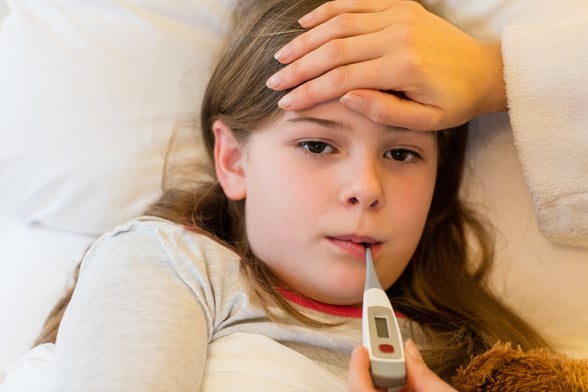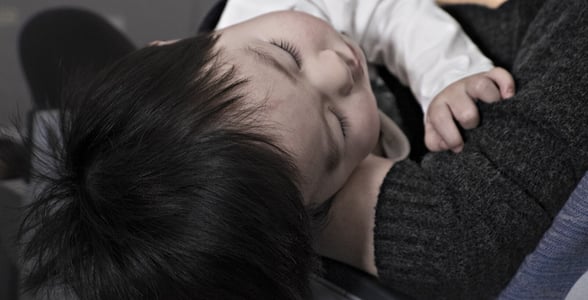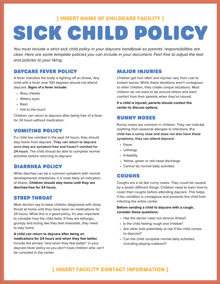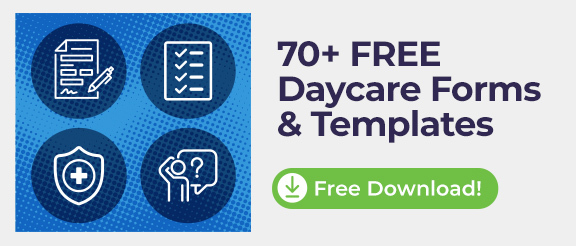Does your daycare need a daycare fever policy? The short answer is yes. Fevers are an important red flag for possible illness. Studies report that children in daycare will have more than eight colds each year. These colds are in addition to strep throat, the flu and other common illnesses that run rampant in settings where children are around each other. As a daycare provider, you're probably wondering what kind of daycare fever policy you need to handle so many sicknesses.
We've created daycare illness policy templates and a checklist to help parents determine if their children should stay home. You can use and adjust these policies as needed and add them to your daycare’s handbook. We've also detailed common diseases and their related symptoms and incubation periods. These excerpts are also useful for your handbook, as they’ll inform parents on whether their children should stay home.
Table of Contents
- Download a Free Editable Daycare Sick Child Policy
- What to Include in a Daycare Sick Child Policy
- Diseases to Include in a Daycare Fever Policy
- Questions Parents Should Consider Before Sending a Child to a Daycare Provider
Download a Free Editable Daycare Sick Child Policy
Making sure parents are informed on your daycare fever policy is important. That’s why programs must provide reminders during cold and flu season. Easily build a daycare sick policy using our free editable template below. You can then print it out and hand it to parents during checkouts to ensure they know your program’s sick policies.
What to Include in a Daycare Sick Child Policy

You must include a strict sick child policy in your daycare handbook so parents’ responsibilities are clear. Here are some template policies you can include in your document.
Daycare Fever Policy
A fever indicates the body is fighting off an illness. Any child with a fever over 100 degrees should not attend daycare. Signs of a fever include:
- Rosy cheeks
- Watery eyes
- Rash
- Hot to the touch
Children can return to daycare after being free of a fever for 24 hours without medication.
Vomiting Policy
If a child has vomited in the past 24 hours, they should stay home from daycare. They can return to daycare once they are symptom-free and haven’t vomited for 24 hours. The child should be able to complete normal activities before returning to daycare.
Diarrhea Policy
While diarrhea can be a common symptom with normal developmental milestones, it’s most likely an indication of illness. Children should stay home until they are diarrhea-free for 24 hours.
Strep Throat
Most doctors say to keep children diagnosed with strep throat at home until they have been on medications for 24 hours. While this is a good policy, it's also important to consider how the child feels. If they are lethargic, grumpy and acting like they feel miserable, they need to stay home.
A child can return to daycare after being on medications for 24 hours and when they feel better. Include the phrase "and when they feel better" in your daycare fever policy so you don't have children who can't be consoled in the center.
Major Injuries
Children get hurt often and injuries vary from cuts to broken bones. While these situations aren't contagious to other children, they create unique situations. Most children do not want to be around others and want comfort from their parents when they’re injured. If a child is injured, parents should contact the center to discuss options.
Runny Noses
Runny noses are common in children. They can indicate anything from seasonal allergies to infections. If a child has a runny nose and does not also have these symptoms, they can attend daycare:
- Fever
- Lethargy
- Irritability
- Yellow, green or red nasal discharge
- Cannot do normal daily activities
Coughs
Coughs are a lot like runny noses. They could be caused by a dozen different things. Children need to learn how to cover their coughs before attending daycare. This helps if the condition is contagious and prevents the child from infecting the entire center.
Before sending a child to daycare with a cough, consider these questions:
- Has the doctor ruled out serious illness?
- Is the child feeling rough and irritable?
- Are other kids potentially at risk if the child comes to daycare?
- Can the child complete normal daily activities, including playing outdoors?
Diseases to Include in a Daycare Fever Policy
 This list isn’t exhaustive, but it includes the most common situations daycares face. Include these conditions in your illness policy.
This list isn’t exhaustive, but it includes the most common situations daycares face. Include these conditions in your illness policy.
Chicken Pox
Chicken pox is a viral infection caused by the varicella-zoster virus. It’s contagious from one to two days before the onset of symptoms to five days after the appearance of the rash.
Chicken pox spreads through contact with infected droplets from coughing and sneezing. It also passes through direct contact with the skin lesions of a person who has chicken pox.
Symptoms: Chicken pox starts with fever, headache and fatigue and then progresses to an itchy rash with fluid-filled blisters. It can be contagious from one to two days before the rash appears until all the blisters have formed scabs. The illness typically lasts seven to 10 days.
Incubation Period: The incubation period for chicken pox is long. It typically ranges between 13 and 17 days; however, in some cases it lasts for three weeks.
Important Considerations:
- Parents should keep children home from daycare until the blisters have dried into scabs.
- Chicken pox is highly contagious but once someone has it, they are generally immune from catching it again.
- It's important to not give children aspirin with chicken pox because it puts them at risk for Reye’s syndrome.
- Children with compromised immune systems or those on immunosuppressive medications are at a higher risk of catching chicken pox.
Common Cold or Respiratory Infections
The common cold is a viral infection of the upper respiratory tract that causes inflammation in the nose and throat. This is an important disease to include in the daycare fever policy. Infected people transmit the virus by spreading droplets from their noses and mouths.
The virus that causes the common cold is called rhinovirus. Rhinovirus is a type of picornavirus, which belongs to the family of enteroviruses.
Symptoms: The symptoms of a common cold are usually mild and include:
- Sore throat
- Coughing
- Sore muscles
- Headache
- Runny nose
- Sneezing
- Fever
Incubation Period: The common cold generally lasts one to three days. When those colds turn to infections or other acute respiratory illnesses, the incubation period can last up to 10 days.
Important Considerations: Parents should keep children home until they are fever-free for 24 hours and feel well enough to participate in normal activities. Regular handwashing and teaching children to cover their coughs and sneezes will help prevent the spread of the common cold.
Influenza
Influenza is an acute respiratory infection caused by the influenza virus. The influenza virus is a type of RNA virus, which means that it has a single strand of RNA for its genetic material. It belongs to the orthomyxovirus family. It’s one of three types of influenza viruses: A, B and C.
People spread influenza through coughing, sneezing or contact with body fluids or droplets.
Symptoms: Symptoms of influenza:
- Fever
- Aches and pains in the muscles, joints and bones
- Headache
- Coughing
- Sore throat
- Runny nose
- Chills
Incubation Period: The incubation period is usually one to three days. Of course, this may vary based on the child and how they handle illness.
Important Considerations: Parents should keep children home until they no longer have a fever. The fever should be gone for 24 hours and the child should feel well enough to complete daily activities.
Head Lice
A head louse is a type of parasite that lives in the hair of humans. The head louse feeds on blood from the scalp and lays eggs. These eggs are called nits and they are found close to the scalp.
When a person has head lice, it’s important to get rid of them as soon as possible. This is because they can cause severe itching, rashes and infections.
Head lice are most often found in children between 4 and 10 years old, but they can also be found in adults. They are most prevalent during the winter months, but they can live year-round if there is no cold weather outside. This is an important condition to include in the daycare fever policy, even though fever isn't a symptom.
Symptoms: There are many symptoms of head lice, including:
- Itching or scratching the head
- Headache
- Redness of the skin around the neck and back of the ears
- Irritated eyes
Incubation Period: Head lice are difficult to get rid of because they lay eggs (nits) close to the scalp. Nits hatch after seven days. Because of this, it’s important to use a shampoo with a proven nit-killing ingredient like permethrin every week for at least three weeks.
Important Considerations:
- Head lice are highly contagious until treated. Parents must keep their children home until they've administered treatment and they no longer find live lice. It's also a good idea to evaluate and treat everyone in the house for lice and nits.
- People pass head lice to others by direct contact. This can be from the person, combs, brushes, bedding, hats or other items that touch the head.
Pink Eye
Pink eye is an inflammation of the conjunctiva, the thin, clear tissue that lines the eyelid and covers the white part of your eye. It’s also called conjunctivitis.
There are two types of pink eye: viral and bacterial. Viral pink eye is usually milder than the bacterial pink eye and resolves on its own without treatment within two weeks. Bacterial pink eyes usually need to be treated with antibiotics for four or five days to clear up completely.
The most common causes of pink eye are viral infections. These include:
- Viral upper respiratory infections
- Viral gastroenteritis
- Chicken pox
- Measles
- Mumps
- Diphtheria
- Whooping cough
Sometimes, you can catch pink eye through hand-eye contact.
Symptoms: Pink eye is a common eye infection stemming from bacteria, viruses, allergies or irritants. Symptoms of pink eye can vary from mild to severe and include:
- Eye pain
- Redness
- Swelling
- Watery discharge
- Irritation of the eyes and eyelids
- Itching of the eyes and eyelids
- Blurry vision
Incubation Period: The incubation period is one to three days. Of course, if it’s the bacterial type, the child will need antibiotics before returning to daycare.
Important Considerations: Children should visit a doctor if symptoms include pus discharge from the eyes. They can return to daycare after being on medication for 24 hours. If the pink eye is viral, children can attend daycare.
Hand, Foot and Mouth Disease
Hand, foot and mouth disease (HFMD) is a common illness you should include in your daycare fever policy. It’s a common illness that occurs in infants and children caused by a virus called Coxsackie A-16.
HFMD is a viral infection. People get it through contact with bodily fluids such as saliva and mucus. You can prevent it by washing your hands with soap and water often.
HFMD causes blister-like sores on the hands, feet and around the mouth.
The virus can be spread through contact with infected people or objects. The virus can live on surfaces for about 24 hours.
Symptoms: The symptoms of HFMD are:
- Fever
- Sore throat
- Muscle or joint pain
- Swollen glands in the neck, armpit or groin area
- Rash on hands, feet and buttocks
- Loss of appetite
Incubation Period: The average incubation period is three to five days. This may vary on the severity of symptoms in your child.
Important Considerations: Parents need to keep children home from daycare until they are fever-free for 24 hours. The child must also feel well enough to participate in daily activities. The sores may still be present even when these things happen.
Strep Throat or Scarlet Fever
Strep throat is an infection of the upper respiratory tract. It’s usually caused by Streptococcus pyogenes bacteria. It spreads by the nose and throat discharges from the person who has it.
The bacteria cause inflammation in the throat, tonsils and adenoids. This leads to a sore throat, bad breath, headache and fever.
Scarlet fever is a strep infection that affects the skin and mucous membranes such as the mouth or nose. The difference between strep throat and scarlet fever is that scarlet fever does not cause a sore throat or cough, but instead causes a rash on the body.
Symptoms: The symptoms of strep throat are:
- Sore throat
- Swollen tonsils
- Red or white coating at the back of the throat
- Stomach issues
- Earaches
- Low-grade fever
- Achiness
The symptoms of scarlet fever are:
- Sore throat
- Swollen tonsils
- Fever (usually above 101 degrees)
- Rash
Incubation Period: The incubation period is usually one to three days. This varies based on the illness and how the child responds to treatment.
Important Considerations: Parents should keep children home until a medical professional confirms they have strep throat. Children should be on antibiotics for at least 24 hours and feel well enough to complete normal daily activities. Children should also be fever-free for 24 hours.
Infectious Diarrhea
We already provided a basic diarrhea policy for the daycare fever policy, but this one is for contagious illnesses. Diarrhea is the passing of loose or watery stools more than two times a day. Diarrhea is also stool that is too liquid, too frequent or too large.
The most common cause of diarrhea is an infection of the intestines. People can get it from bacteria, viruses, parasites and other organisms found in food and water. There are also many other causes of diarrhea, including illnesses and medications.
Symptoms: Common symptoms include:
- Abdominal pain
- Nausea
- Vomiting
- Fever (usually low-grade)
- Dehydration
Incubation Period: The incubation period varies based on why the child has diarrhea. It can range between a day or two to a few weeks.
Important Considerations: As long as the germs are present, the child can pass them on. Children should stay home until they no longer have diarrhea and are fever-free for 24 hours.
Whooping Cough
Whooping cough is a highly contagious respiratory infection. It’s caused by the bacteria Bordetella pertussis. Whooping cough can be treated with antibiotics, but the best way to prevent it is through vaccination.
Whooping cough is also called pertussis and can be life-threatening to infants. It’s contagious and can spread through droplets in the air or contact with someone who has it.
The most common symptom of whooping cough is a persistent, hacking cough that can last for up to 10 weeks. The coughing can be so severe that it leads to vomiting or fainting from lack of oxygen
Symptoms: The symptoms of whooping cough are:
- Severe coughing spells that end in a “whoop” sound
- Runny nose, sneezing or nasal congestion
- A fever, which may be as high as 102°F
- A dry hacking cough that lasts for at least three weeks and can last for months or years
Incubation Period: The incubation period can be as few as six days or more than 20.
Important Considerations: Children may be contagious until three weeks after their symptoms first started. Parents must keep children home until they have received treatment for at least five days.
Questions Parents Should Consider Before Sending a Child to a Daycare Provider

Sometimes, it's hard for parents to know when to send their children to daycare and when to take precautions. You can include this checklist in your daycare fever policy. When kids are just starting to get sick or getting over an illness, parents should answer these questions before sending them to daycare.
Can Your Child Cover Their Cough?
Parents need to consider if their child can cover their cough before sending them to daycare. By doing so, they protect themselves and the other children in the daycare and help the child recover faster.
A cough is a symptom of an illness that needs medical attention and may need treatment with medication. It does not go away on its own. Don't ignore a cough.
Is Your Child Tired or Lethargic?
Parents should consider if their child is tired or lethargic before sending them to daycare. The reason is sometimes parents aren’t aware that their child might be sick and may need a doctor.
Parents need to be aware of the signs that their child may be too tired to go to daycare. Some of these signs include:
- Lethargy
- Lack of energy or enthusiasm
- Slow responses
- Headaches
- Difficulty breathing or swallowing
- Difficulty waking up from sleep
- Irritability, crankiness or crying
If the child seems lethargic, parents should know that this could mean they are sick. They should consult a doctor for more information about the child’s symptoms. This will help them determine what to do next.
Is Your Child Difficult to Console?
Parents are often faced with the decision of whether or not to send their children to daycare when sick or getting over an illness. Parents should take into consideration if their child is difficult to console before sending them. If a child is difficult to console, it can be a sign of emotional distress.
Can Your Child Complete Daily Activities?
Parents and guardians of children in daycare centers must identify when their children don’t feel well enough to complete daily activities at school. These activities can include going outside for recess or playing with friends. These children must have an opportunity to rest and recover from their illnesses before returning to full activity.
Can Your Child Play Outdoors?
Parents are often hesitant to send their children to daycare if they feel like the children aren’t well enough to play outdoors. However, most daycares require all children to be able to play outside. This is because a lack of outdoor time can impact the child's development.
Parents should consider if their child feels well enough to play outdoors before sending them to daycare. If they don't, then it may be a good idea for them to stay home and rest. This should be clear in the daycare fever policy.
Is Your Child Irritable or Uncomfortable?
Parents need to be aware of the signs that their children are experiencing discomfort, pain or anxiety before sending them to daycare. If a child is irritable or uncomfortable, they need to take a break from the environment and allow their body to heal.
What are some signs that your child isn’t feeling well?
- Does your child have a fever?
- Do they look unusually pale or flushed?
- Are they coughing, wheezing, sneezing or having difficulty breathing?
- Is their nose stuffy and does it drip with mucus?
- Are their eyes watery and red?
- Do they complain of aches and pains like headaches or body aches?
Get 70+ Editable Daycare Templates for Almost Every Situation
 We know daycare providers like yourself are busy. That's why we made dozens of templates to help you manage the various aspects of your organization. From billing and invoicing to marketing materials, we have it all. Download all 70 today!
We know daycare providers like yourself are busy. That's why we made dozens of templates to help you manage the various aspects of your organization. From billing and invoicing to marketing materials, we have it all. Download all 70 today!













